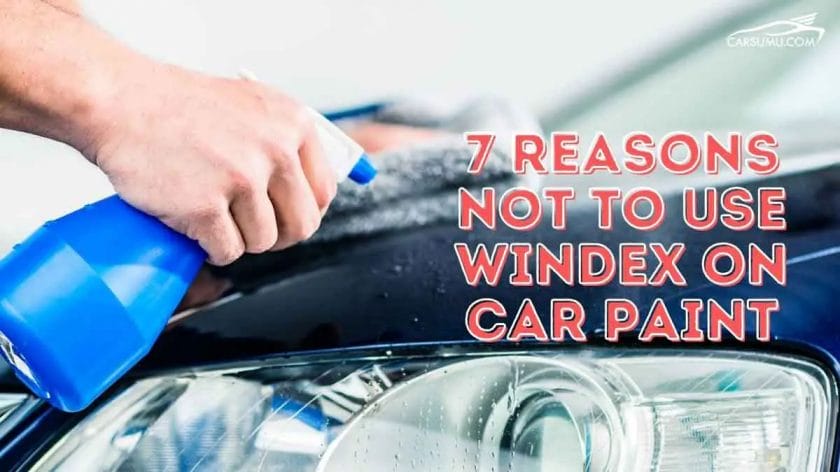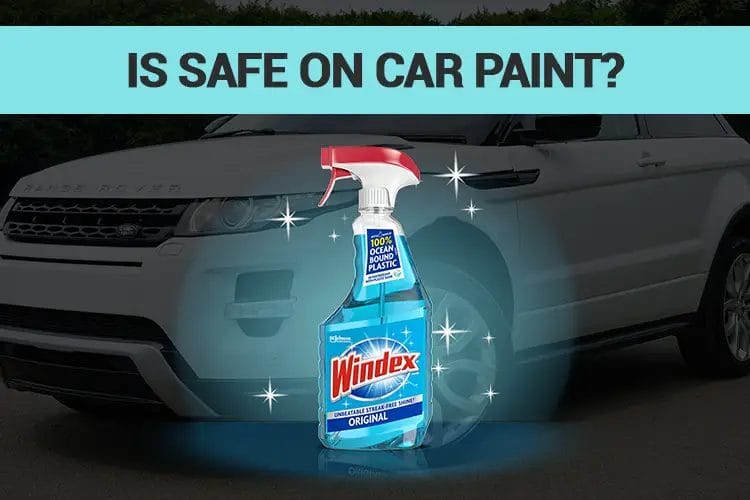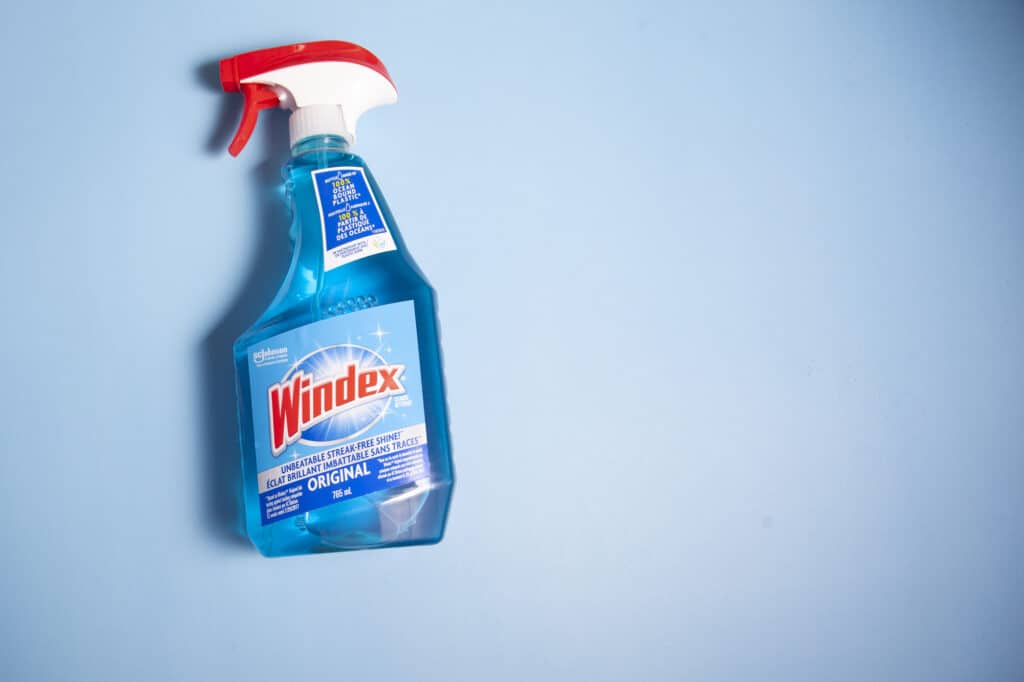Using Windex on car paint is not recommended as it is primarily designed for cleaning glass surfaces. Windex contains chemicals that can be too harsh for automotive paint, causing it to fade or become discolored over time. It’s best to use products specifically formulated for car paint, such as car wash soap and detailing products, to maintain the shine and protect the paint finish.

The Pros and Cons of Using Windex on Car Paint
When it comes to cleaning your car, there are countless products available on the market. One such product that you may have heard of is Windex, a popular household glass cleaner. While it may seem convenient to use Windex on your car’s paint, there are both pros and cons to consider before using it.
Pros of Using Windex on Car Paint
- Effective for removing dirt and grime: Windex is known for its ability to cut through tough grease and grime. When used on car paint, it can effectively remove dirt and other contaminants, leaving your vehicle looking clean and shiny.
- Easy to use: Windex is readily available and easy to use. Simply spray it onto the surface of your car and wipe it clean with a microfiber cloth.
- Affordable: Compared to some car-specific cleaning products, Windex is generally more affordable. This can be a cost-effective option for regular car maintenance.
Cons of Using Windex on Car Paint
- Potential damage to clear coat: Car paint is protected by a clear coat, which adds shine and provides a barrier against environmental elements. Windex contains chemicals that may strip away the clear coat over time, leading to a dull appearance.
- Not designed for automotive use: Windex is primarily formulated for glass cleaning, not for automotive surfaces. It may not have the same level of protection and compatibility with car paint as products specifically made for automotive use.
- No added protection: Unlike some car cleaning products, Windex does not provide any additional protection for your car’s paint. It may clean the surface, but it won’t offer the same level of longevity and protection against UV rays and other environmental factors.
Best Practices for Using Windex on Car Paint
If you still choose to use Windex on your car’s paint, it’s important to follow some best practices to minimize any potential risks:
- Dilute the solution: Consider diluting the Windex with water before applying it to your car’s paint. This can help reduce the concentration of chemicals and minimize the risk of damage to the clear coat.
- Avoid direct sunlight: It’s best to clean your car in a shaded area to prevent the Windex from drying too quickly on the paint surface, which could potentially lead to streaks or damage.
- Test in a small area: Before applying Windex to the entire car, test it on a small, inconspicuous area to ensure there are no adverse reactions or damage to the paint.
- Rinse thoroughly: After cleaning with Windex, be sure to rinse the car thoroughly with water to remove any residue and prevent chemical buildup.
In Summary
Using Windex on car paint can be a convenient option for cleaning, but it comes with its own set of pros and cons. While it can effectively remove dirt and grime and is relatively affordable, there is a risk of potential damage to the clear coat and it does not offer additional protection for your car’s paint. If you still choose to use Windex, dilute the solution, clean in a shaded area, test in a small area, and rinse thoroughly to minimize any potential risks.

Alternative Cleaning Solutions for Car Paint
Keeping your car’s paint clean and well-maintained is essential for its appearance and longevity. While there are many commercial cleaning solutions available in the market, some people prefer using alternative methods to clean their car paint. These alternative solutions are often more eco-friendly and cost-effective. In this section, we will explore some of these alternative cleaning solutions that you can use to keep your car paint looking pristine.
Vinegar Solution
Vinegar is a versatile and natural cleaning agent that can be used to remove dirt and grime from car paint. To make a vinegar solution, mix equal parts of white vinegar and water in a spray bottle. Spray the solution onto the painted surface and let it sit for a few minutes. Then, gently wipe the surface with a microfiber cloth or sponge. Vinegar helps to dissolve and lift dirt, leaving your car paint clean and shiny.
Baking Soda Paste
Baking soda is another effective alternative for cleaning car paint. Create a paste by mixing baking soda with water until it forms a thick consistency. Apply the paste onto a damp cloth and gently scrub the painted surface in a circular motion. Baking soda acts as a mild abrasive that can remove stains and restore the brightness of the paint. Rinse the surface with water and dry it thoroughly after using the baking soda paste.
Lemon Juice and Olive Oil Mixture
If you prefer a natural cleaning solution with a pleasant scent, you can try a mixture of lemon juice and olive oil. Combine equal parts of lemon juice and olive oil in a spray bottle. Shake the bottle to mix the ingredients thoroughly. Spray the mixture onto the car paint and use a soft cloth to gently rub the surface. Lemon juice acts as a mild cleanser while olive oil helps to condition and protect the paint.
Club Soda
Club soda is not only a refreshing beverage but can also be used to clean car paint. Pour some club soda onto a clean cloth or sponge and gently dab it onto the painted surface. The carbonation in club soda helps to lift stains and dirt from the paint. After dabbing the surface, wipe it dry with a clean cloth. Club soda is particularly effective in removing bird droppings or insect residue.
Waterless Car Wash
If you are looking for a convenient and water-saving alternative, a waterless car wash product can be a great option. These products come in the form of sprays or wipes that contain a blend of cleaning agents and lubricants. Simply spray or wipe the product onto the car paint, and then use a microfiber cloth to gently buff and polish the surface. Waterless car wash solutions are designed to lift dirt and provide a protective layer on the paint.
Summary
Although commercial cleaning solutions are widely available, alternative methods can offer effective and eco-friendly options for cleaning car paint. Vinegar, baking soda, lemon juice and olive oil mixture, club soda, and waterless car wash products are just a few examples of alternative cleaning solutions that you can use. Experiment with these options and find the one that works best for your car paint. Remember to always test any cleaning solution on a small, inconspicuous area before applying it to the entire surface.

Expert Tips for Maintaining Car Paint’s Shine
Keeping your car’s paint looking shiny and new requires regular maintenance and care. Here are some expert tips to help you maintain the shine of your car’s paint:
1. Wash your car regularly
Regularly washing your car is essential to remove dirt, dust, and other contaminants that can dull the paint’s shine. Use a dedicated car wash soap and a soft sponge or microfiber cloth to gently clean the surface. Avoid using harsh or abrasive cleaners that can damage the paint.
2. Dry your car properly
After washing your car, it’s important to dry it properly to prevent water spots and streaks. Use a clean microfiber towel or a chamois to gently dry the surface. Avoid air drying or letting water evaporate on its own, as this can leave behind minerals and impurities that can mar the paint’s finish.
3. Apply a protective wax or sealant
Applying a layer of wax or sealant to your car’s paint can help protect it from environmental elements and maintain its shine. Choose a high-quality wax or sealant and follow the manufacturer’s instructions for application. Regularly reapply the wax or sealant to ensure continued protection.
4. Avoid parking in direct sunlight
Prolonged exposure to sunlight can fade and damage the paint on your car. Whenever possible, park in shaded areas or use a car cover to protect your vehicle from harmful UV rays. If you must park in the sun, consider using a UV-resistant car wax or coating for added protection.
5. Keep your car away from harsh chemicals
Avoid parking or driving your car near areas where harsh chemicals are present, such as industrial sites or construction zones. Chemicals like solvents, acids, and detergents can damage the paint and strip away its shine. If your car does come into contact with any chemicals, wash it as soon as possible to minimize damage.
6. Be mindful of bird droppings and tree sap
Bird droppings and tree sap can be highly corrosive and damaging to your car’s paint. If you notice any bird droppings or tree sap on your vehicle, clean it off immediately to prevent any permanent damage. Use a gentle cleaner and a soft cloth to remove the residues.
7. Avoid abrasive materials
When cleaning your car or removing stubborn stains, avoid using abrasive materials like rough sponges, scrub brushes, or abrasive cleaners. These can scratch the paint and dull its shine. Instead, opt for soft microfiber cloths and gentle cleaning products specifically designed for automotive use.
8. Regularly inspect and touch up paint chips
Small paint chips and scratches can quickly escalate and lead to more significant damage if left unattended. Regularly inspect your car’s paint for any chips or scratches and touch them up promptly with touch-up paint. This will help prevent rust and preserve the overall shine of your car’s paint.
9. Protect your car from excessive heat
Excessive heat can damage your car’s paint and cause it to fade or crack. Whenever possible, park your car in shaded areas or use a car sunshade to shield it from direct sunlight. Additionally, consider using a paint protection film or ceramic coating for added heat resistance and protection.
10. Schedule professional detailing
While regular maintenance is important, professional detailing can help rejuvenate and enhance the shine of your car’s paint. Schedule regular professional detailing sessions to deep clean, polish, and protect your car’s paint. Professional detailers have the expertise and tools to restore your car’s shine to its former glory.
In summary, maintaining the shine of your car’s paint requires regular care and attention. Follow these expert tips to keep your car looking its best and protect its paint from damage. Remember to wash and dry your car regularly, apply protective wax or sealant, avoid harsh chemicals, and be mindful of bird droppings and tree sap. Additionally, protect your car from excessive heat and schedule professional detailing for optimal results. With proper care, your car’s paint will continue to shine for years to come.
Top Myths about Using Windex on Car Paint Debunked
When it comes to cleaning your car’s paint, there are many myths and misconceptions floating around. One popular belief is that using Windex, a common household glass cleaner, is a quick and effective way to clean your car’s paint. However, this is not entirely true. In this section, we will debunk some of the top myths about using Windex on car paint.
Myth 1: Windex is safe for all car paints
One of the most common misconceptions about Windex is that it is safe to use on all types of car paints. However, this is not the case. Windex contains ammonia, which can be harmful to certain types of car paints, especially those with clear coats. The ammonia in Windex can cause the clear coat to become hazy and dull over time, ruining the appearance of your car’s paint.
It is important to note that not all car paints are created equal. Different manufacturers use different types of paint, and each type requires specific care and maintenance. It is always best to consult your car’s manual or the paint manufacturer’s recommendations before using any cleaning products on your car’s paint.
Myth 2: Windex cleans car paint better than other products
Another misconception is that Windex is a superior cleaner for car paint compared to other products specifically formulated for automotive use. While Windex may be effective at removing dirt and grime from glass surfaces, it is not designed to effectively clean car paint.
Automotive-specific cleaning products are formulated to safely and effectively remove dirt, road grime, and other contaminants from car paint without causing damage. These products are pH balanced and do not contain harsh chemicals that can strip away the protective wax or clear coat on your car’s paint.
Myth 3: Windex leaves no streaks on car paint
Another myth is that Windex leaves no streaks or residue on car paint, providing a streak-free shine. However, this is not always the case. Windex, when used on car paint, can leave behind streaks and residue, especially if not properly wiped or buffed off.
Streaks and residue can make your car’s paint appear dull and unattractive. To avoid this, it is best to use a high-quality car wash soap and a soft microfiber cloth specifically designed for automotive use. These products will help to minimize streaks and residue, leaving your car’s paint looking clean and glossy.
Myth 4: Windex can remove scratches from car paint
A common misconception is that Windex can magically remove scratches from car paint. The reality is that Windex is not designed to repair or remove scratches from car paint. While it may temporarily mask the appearance of minor scratches, it does not provide a long-lasting solution.
If your car has scratches or other paint imperfections, it is best to consult a professional auto body shop or a qualified paint specialist. They have the expertise and tools necessary to properly assess and repair the damage, ensuring that your car’s paint looks its best.
Myth 5: Windex is a cost-effective alternative to car wash products
Lastly, there is a misconception that using Windex as a car cleaner is a cost-effective alternative to purchasing dedicated car wash products. While Windex may be cheaper in the short term, using it on your car’s paint can result in long-term damage and costly repairs.
Investing in high-quality car wash products specifically designed for automotive use is a wise choice. These products are formulated to clean and protect your car’s paint without causing harm. They are pH balanced, gentle on the paint, and help maintain its shine and longevity.
Summary
Using Windex on car paint is a popular myth, but it is important to debunk these misconceptions. Windex is not safe for all car paints, and it is not an effective or recommended cleaner for car paint. It can leave streaks and residue, and it is not a solution for removing scratches. Investing in automotive-specific cleaning products is essential to maintain the appearance and longevity of your car’s paint. By following the proper cleaning and maintenance techniques, you can keep your car’s paint looking its best for years to come.
FAQs
Can I use Windex on car paint?
No, it is not recommended to use Windex on car paint. Windex is a glass cleaner that contains ammonia, which can damage the paint and clear coat of a car. It is best to use a car-specific cleaner or mild soap and water to clean the car’s paint surface.
What should I use to clean my car’s paint?
For cleaning car paint, it is recommended to use a car-specific cleaner or mild soap and water. These products are formulated to be gentle on the paint surface and will not cause any damage. Remember to use a soft cloth or sponge and avoid using abrasive materials that can scratch the paint.
How often should I clean my car’s paint?
It is recommended to clean the car’s paint regularly to maintain its appearance and protect it from contaminants. As a general guideline, you should wash your car every 2 weeks or whenever it appears dirty. However, if you live in an area with harsh weather conditions or your car is frequently exposed to dirt and debris, more frequent cleaning may be necessary.
Conclusion
In conclusion, using Windex on car paint is not recommended. While Windex is a popular household cleaner, it is not designed specifically for automotive use. The chemicals in Windex can be harsh and may cause damage to the paint, such as fading or discoloration. Additionally, Windex may not effectively remove stubborn stains or contaminants from the car’s surface. It is always best to use products that are formulated and tested for automotive purposes to ensure the longevity and appearance of the paint. Therefore, it is advisable to avoid using Windex on car paint and opt for automotive-approved cleaning products instead.
In summary, protecting the paintwork of your car is crucial for its overall aesthetic and value. So, using specialized automotive cleaners and following recommended cleaning techniques will ensure the longevity and shine of your car’s paint.
